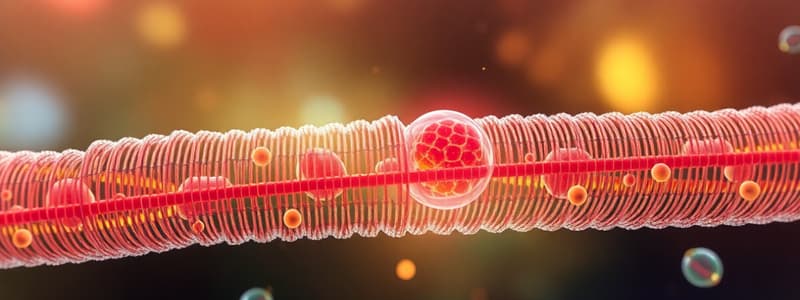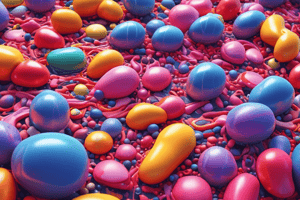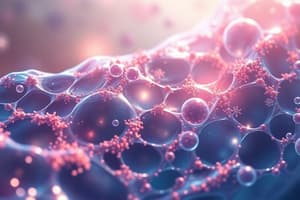Podcast
Questions and Answers
What type of backbone do glycerol-based phospholipids possess?
What type of backbone do glycerol-based phospholipids possess?
- Fatty acid backbone
- Steroid backbone
- Glycerol or sphingosine backbone (correct)
- Cholesterol backbone
Which of the following statements about glycolipids is true?
Which of the following statements about glycolipids is true?
- Glycolipids are exclusively found in the human ABO blood groups.
- Glycolipids do not contain carbohydrate groups.
- All glycolipids are sphingosine-based.
- Some glycolipids are glycerol-based and called glycoglycerolipids. (correct)
What role do glycosphingolipids have in relation to blood groups?
What role do glycosphingolipids have in relation to blood groups?
- They are enzymes that process blood cells.
- They are involved in energy storage.
- They act as specific cell surface markers for blood groups. (correct)
- They provide structural support to red blood cells.
What is sodium dodecyl sulfate (SDS) primarily used for in laboratories?
What is sodium dodecyl sulfate (SDS) primarily used for in laboratories?
Which of the following correctly describes phosphosphingolipids?
Which of the following correctly describes phosphosphingolipids?
What primary function does the plasma membrane serve in relation to the cell?
What primary function does the plasma membrane serve in relation to the cell?
Which structure is embedded in the lipid bilayer and contributes to the membrane's function?
Which structure is embedded in the lipid bilayer and contributes to the membrane's function?
What component primarily constitutes the main fabric of biological membranes?
What component primarily constitutes the main fabric of biological membranes?
Which type of membrane protein is characterized by being amphipathic and may extend through the membrane?
Which type of membrane protein is characterized by being amphipathic and may extend through the membrane?
What is the role of cholesterol in the plasma membrane?
What is the role of cholesterol in the plasma membrane?
How do peripheral proteins primarily interact with the membrane?
How do peripheral proteins primarily interact with the membrane?
What is the function of membrane transporters and ion channels within the plasma membrane?
What is the function of membrane transporters and ion channels within the plasma membrane?
What distinguishes integral membrane proteins from peripheral proteins?
What distinguishes integral membrane proteins from peripheral proteins?
Which statement is true regarding the composition of the phospholipid bilayer?
Which statement is true regarding the composition of the phospholipid bilayer?
What type of membrane protein is specifically linked to the lipid bilayer through a fatty acid or isoprenyl group?
What type of membrane protein is specifically linked to the lipid bilayer through a fatty acid or isoprenyl group?
What impact do double bonds in hydrocarbon chains have on their arrangement?
What impact do double bonds in hydrocarbon chains have on their arrangement?
How does cholesterol influence membrane fluidity at high temperatures in animal cells?
How does cholesterol influence membrane fluidity at high temperatures in animal cells?
What effect does cholesterol have on lipid chains at low temperatures?
What effect does cholesterol have on lipid chains at low temperatures?
What characterizes the fluid mosaic model of membranes?
What characterizes the fluid mosaic model of membranes?
What percentage of the total membrane lipid in a typical animal cell is cholesterol?
What percentage of the total membrane lipid in a typical animal cell is cholesterol?
What is the main role of transport proteins in cellular membranes?
What is the main role of transport proteins in cellular membranes?
Which type of transport protein allows the movement of two different types of molecules in the same direction?
Which type of transport protein allows the movement of two different types of molecules in the same direction?
What distinguishes ligand-gated ion channels from other types of ion channels?
What distinguishes ligand-gated ion channels from other types of ion channels?
Which mechanism is primarily responsible for transporting materials against their concentration gradient?
Which mechanism is primarily responsible for transporting materials against their concentration gradient?
What is the energy source for active transport processes in cells?
What is the energy source for active transport processes in cells?
How do coupled transporters function in cellular transport?
How do coupled transporters function in cellular transport?
What occurs during exocytosis?
What occurs during exocytosis?
What is the primary function of gap junctions?
What is the primary function of gap junctions?
Which type of transport protein allows only a single type of molecule to pass through?
Which type of transport protein allows only a single type of molecule to pass through?
What occurs during endocytosis?
What occurs during endocytosis?
What dynamic property do lipid bilayers exhibit in response to disruption?
What dynamic property do lipid bilayers exhibit in response to disruption?
Which type of ion channel opens in response to changes in membrane potential?
Which type of ion channel opens in response to changes in membrane potential?
Which process allows the removal of various substances from the cell?
Which process allows the removal of various substances from the cell?
What results from the mechanical opening of ion channels in response to sound waves?
What results from the mechanical opening of ion channels in response to sound waves?
What is the primary function of membranes in cells?
What is the primary function of membranes in cells?
Which type of transport requires energy?
Which type of transport requires energy?
How does passive transport occur across membranes?
How does passive transport occur across membranes?
What plays a crucial role in the facilitated diffusion of solutes?
What plays a crucial role in the facilitated diffusion of solutes?
What is osmosis specifically concerned with?
What is osmosis specifically concerned with?
What effect does a hypertonic solution have on red blood cells?
What effect does a hypertonic solution have on red blood cells?
What is a characteristic of facilitated diffusion?
What is a characteristic of facilitated diffusion?
Which substances typically require transport proteins to move across cell membranes?
Which substances typically require transport proteins to move across cell membranes?
What happens to red blood cells in an isotonic solution?
What happens to red blood cells in an isotonic solution?
How do membranes contribute to cellular communication?
How do membranes contribute to cellular communication?
What defines the permeability barrier of the cell membrane?
What defines the permeability barrier of the cell membrane?
What characterizes active transport processes?
What characterizes active transport processes?
What effect does a hypotonic solution have on a red blood cell?
What effect does a hypotonic solution have on a red blood cell?
What drives the direction of movement in passive transport?
What drives the direction of movement in passive transport?
What are the three sub-phases of Interphase, and what key processes occur in each?
What are the three sub-phases of Interphase, and what key processes occur in each?
Describe the role of checkpoints in the cell cycle.
Describe the role of checkpoints in the cell cycle.
What are the stages of Mitosis, and what occurs during Anaphase?
What are the stages of Mitosis, and what occurs during Anaphase?
What distinguishes Mitosis from Meiosis in terms of daughter cells produced?
What distinguishes Mitosis from Meiosis in terms of daughter cells produced?
Explain the significance of apoptosis in the context of the cell cycle.
Explain the significance of apoptosis in the context of the cell cycle.
What happens during Cytokinesis, and how does it differ in plant and animal cells?
What happens during Cytokinesis, and how does it differ in plant and animal cells?
How do cyclins and cyclin-dependent kinases (CDKs) regulate the cell cycle?
How do cyclins and cyclin-dependent kinases (CDKs) regulate the cell cycle?
What is the main purpose of the S Phase in the cell cycle?
What is the main purpose of the S Phase in the cell cycle?
What is the function of 'crossing over' during Meiosis, and when does it occur?
What is the function of 'crossing over' during Meiosis, and when does it occur?
How does the structure of chromosomes change from Prophase to Telophase?
How does the structure of chromosomes change from Prophase to Telophase?
Flashcards are hidden until you start studying
Study Notes
Cell Membrane Structure and Function
- The plasma membrane defines the boundary of the cell and any of its internal compartments including organelles like mitochondria, nucleus, and chloroplasts.
- The plasma membrane is semi-permeable, allowing selective passage of substances.
- The biological membrane is a lipid bilayer with proteins embedded or associated with the bilayer.
- Biological membranes are stable in water.
- The lipid bilayer is impermeable to charged or polar solutes, but membrane transporters and ion channels allow passage of specific solutes.
- All of the internal membranes of cells are part of an interconnected, functionally specialized, and dynamic endomembrane system.
Membrane Components
- Components of the plasma membrane include phospholipids, integral proteins, peripheral proteins, carbohydrates, and cholesterol.
- Phospholipids are the main fabric of the membrane.
- Integral proteins are embedded in, and may or may not extend through, the phospholipid bilayer.
- Peripheral proteins are attached to the phospholipid bilayer but not embedded in its hydrophobic core, or are attached to proteins or lipids on the extracellular side of the membrane.
- Carbohydrates are attached to proteins or lipids on the extracellular side of the membrane, forming glycoproteins and glycolipids.
- Cholesterol is tucked between the hydrophobic tails of the membrane phospholipids.
- The composition of the two layers of the phospholipid bilayer membrane is not identical (e.g., bulkier molecules are more often found in the inner side of the membrane).
Integral Membrane Proteins
- Integral membrane proteins are amphipathic, with at least one hydrophobic region at the membrane interior and at least one hydrophilic region extended outward.
- Transmembrane proteins are a type of integral membrane protein that extend across the membrane.
Peripheral Proteins
- Peripheral proteins can be either lipid-anchored membrane proteins or bound to integral membrane proteins.
- Lipid-anchored membrane proteins are located on one of the surfaces of the lipid bilayer, and are attached by covalent linkage to a fatty acid, isoprenyl, or glycosylphosphatidylinositol (GPI).
Membrane Lipids
- Phospholipids are composed of a small polar head group (such as choline) attached to a fatty acid-containing glycerol or sphingosine backbone.
- Glycerol-based phospholipids are called phosphoglycerolipids (phosphoglycerides).
- Sphingosine-based phospholipids are called phosphosphingolipids.
- Glycolipids are formed by adding carbohydrate groups to lipids.
- Glycoglycerolipids are glycerol-based glycolipids.
- Glycosphingolipids are sphingosine-based glycolipids.
- Human ABO blood groups are determined by glycosphingolipids called A and B antigens, which serve as cell surface markers.
Membrane Fluidity
- Membrane fluidity is influenced by temperature and the degree of fatty acid saturation.
- Kinks caused by double bonds in fatty acids prevent hydrocarbon chains from fitting together snugly, increasing membrane fluidity.
- Cholesterol affects membrane fluidity, acting as a fluidity buffer and helping to maintain fairly constant fluidity despite temperature or saturation fluctuations.
Fluid Mosaic Model
- The fluid mosaic model, proposed by S. Jonathan Singer and Garth Nicolson in 1972, describes the structure of membranes as a fluid lipid bilayer with embedded proteins and carbohydrates.
Membrane Functions
- Membranes function as boundaries of cells and organelles, acting as permeable barriers between internal and external environments.
- Membranes serve as sites for specific biochemical functions.
- Membranes contain transport proteins that regulate substance movement across the cell.
- Membranes possess protein receptors to detect extracellular signals.
- Membranes provide mechanisms for cell-to-cell contact, adhesion, and communication.
Boundary and Permeability Barrier:
- Membranes define the boundaries of cells and their compartments, separating the interior of the cell from the surrounding environment.
- Membranes are an effective permeability barrier for polar molecules and ions, preventing their free passage.
- Intracellular membranes compartmentalize functions within eukaryotic cells.
Specific Functions
- Specific proteins embedded in or localized on membranes give the membrane a specific function.
- Examples of specific membrane functions include:
- Cell membrane enzymes that secrete materials for the extracellular matrix.
- Ion transporters in nerve cell membranes essential for signal transmission to muscles.
Transport Across the Membrane
- Most substances that move across membranes are not macromolecules.
- Membrane proteins carry out and regulate the transport of nutrients, ions, gases, water, and other substances into and out of cells and organelles.
- While some substances (gases, small or lipophilic molecules) can diffuse directly across membranes, most substances needed by the cell are hydrophilic and require transport proteins.
- Cells may have specific transporters for importing glucose, amino acids, or other nutrients.
Transport Mechanisms
- Transport mechanisms can be either passive or active.
- Passive transport is the movement of substances across the membrane without energy expenditure, following concentration gradients or electrochemical potentials.
- Active transport requires energy.
- Types of passive transport include simple diffusion and facilitated diffusion.
- Types of active transport include coupled transporters, ATP-driven pumps, and light-driven pumps.
Simple Diffusion
- Simple diffusion is the movement of solutes or molecules from a region of higher concentration to a region of lower concentration.
- Molecules move down a concentration gradient.
- Simple diffusion is a passive process that requires no energy.
Osmosis
- Osmosis is the diffusion of water molecules from one side of a selectively permeable (semi-permeable) membrane to the other.
- The cell membrane is naturally permeable to water and water flow across membranes is always passive.
- Tonicity describes the effect of an extracellular solution on the volume of a cell, determined by the relative concentration of non-penetrating solute molecules.
- Hypertonic solutions cause cells to shrink as water leaves the cell.
- Hypotonic solutions cause cells to swell as water enters the cell.
- Isotonic solutions do not affect cell volume.
Facilitated Diffusion
- Facilitated diffusion is the passive movement of solutes (molecules, ions) across the membrane through transport proteins (protein channels or carrier proteins).
- Solutes move along the concentration gradient.
- Facilitated diffusion is a selective process.
- Facilitated diffusion is a passive process, requiring no energy.
Transport Proteins
- Uniports transport a single type of molecule across the membrane.
- Symports transport two different types of molecules in the same direction across the membrane.
- Antiports transport two different types of molecules in opposite directions across the membrane.
Ion Channels
- Ion channels allow passage of specific ions and can be gated by:
- Ligands: Triggered by binding of specific substances, like the nicotinic acetylcholine receptor for Na+ ions passage.
- Mechanical forces: Triggered by mechanical forces, such as sound waves bending cilia on hair cells, which open ion channels and create nerve impulses.
- Changes in membrane potential: Triggered by changes in the membrane potential, such as calcium channels at the synapse of neurons.
Active Transport
- Active transport is a process that requires energy to move molecules against their concentration gradient, from a low concentration to a high concentration.
- Active transport is mediated by transport proteins and uses cellular energy, such as ATP.
- Major functions of active transport include:
- Uptaking essential nutrients from the environment.
- Removing waste products from the cells.
- Maintaining constant imbalance of electro-potential.
- Large molecules like starch are actively transported across the plasma membrane by processes known as exocytosis and endocytosis.
Exocytosis and Endocytosis
- Exocytosis describes the release of substances from the cell through vesicle fusion with the plasma membrane.
- Endocytosis describes the intake of substances into the cell through vesicle formation.
- Active transport processes can involve coupled transporters, ATP-driven pumps, and light-driven pumps.
The Erythrocyte (Red Blood Cell)
- Erythrocytes possess specific transport processes, such as the transport of glucose and sodium ions.
Exocytosis of Neurotransmitters at the Synapse
- Exocytosis plays a vital role in the transmission of nerve impulses at the synapse through the release of neurotransmitters.
Function – Signal Transduction
- Membrane proteins detect and transmit electrical and chemical signals, a process known as signal transduction.
- Membrane proteins mediate cell adhesion and cell-to-cell communication.
Membrane Self-Sealing
- Lipid bilayers can self-seal when disrupted due to the lateral flow of lipid molecules.
- Small breaks in the cell membrane spontaneously seal.
The Cell Cycle
- The cell cycle is a series of stages that a cell goes through to grow and divide.
- Interphase, the longest phase of the cell cycle, is divided into three sub-phases:
- G1 Phase (Gap 1): The cell grows and performs its normal functions, preparing for DNA replication.
- S Phase (Synthesis): DNA replication occurs, creating two identical sister chromatids for each chromosome.
- G2 Phase (Gap 2): The cell continues growing, preparing for mitosis, and checks for DNA damage.
- M Phase (Mitosis), the division of the nucleus, is comprised of several important stages:
- Prophase: Chromatin condenses into chromosomes, and the mitotic spindle begins to form.
- Metaphase: Chromosomes line up at the cell equator.
- Anaphase: Sister chromatids are pulled apart to opposite ends of the cell.
- Telophase: Chromosomes decondense, and nuclear envelopes reform around each set of chromosomes.
Cell Division
- Mitosis: A type of cell division that produces two identical daughter cells. It's fundamental for growth, repair, and asexual reproduction. Mitosis involves only one round of division.
- Meiosis: A type of cell division that produces four genetically diverse daughter cells, known as gametes. It is essential for sexual reproduction, and involves two rounds of division: Meiosis I and Meiosis II. Meiosis introduces genetic variation through crossing over and independent assortment.
Cell Cycle Regulation
- The cell cycle is tightly controlled by checkpoints at G1, G2, and M phases to ensure proper cell division.
- Cyclins and cyclin-dependent kinases (CDKs) are crucial proteins that regulate these checkpoints.
- Errors in cell cycle regulation can lead to uncontrolled cell division, resulting in cancer.
Apoptosis
- Apoptosis is a programmed cell death that is critical for eliminating damaged or unwanted cells during development and tissue homeostasis.
Studying That Suits You
Use AI to generate personalized quizzes and flashcards to suit your learning preferences.




